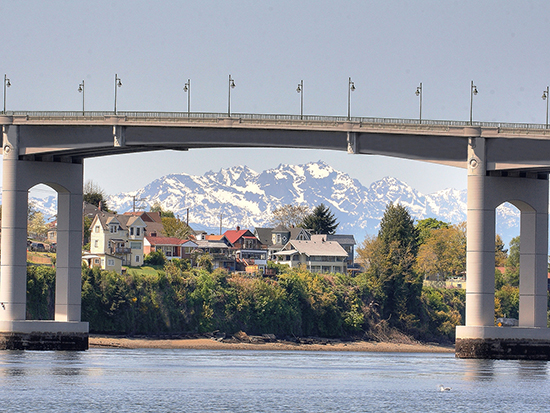|
Subscribe / Renew |
|
|
Contact Us |
|
| ► Subscribe to our Free Weekly Newsletter | |
| home | Welcome, sign in or click here to subscribe. | login |
Construction
| |
 |
May 17, 2013
Public works: Bridges
Manette Bridge replacement
Location: Bremerton
Owner/developer: Washington State Department of Transportation
Project team: Manson-Mowat Joint Venture, general contractor; WSDOT, architect and structural engineer; Concrete Technology Corp., concrete contractor; Kitsap Ready Mix, ready-mix supplier
The Manette Bridge replacement project in Bremerton was unique and challenging in several ways. It replaced an 80-year-old steel truss bridge that was very important to the city and neighborhoods it connects.
The replacement bridge is 1,550 feet long, carries two traffic lanes, two 5-foot-wide shoulders and a 12-foot-wide bike-pedestrian path. The superstructure is seven spans consisting of five typical 250-foot spans, with end spans of 140 feet and 160 feet. The final construction cost was $60 million.
The replacement bridge was constructed 3 feet from the existing bridge while the existing bridge was kept open to traffic. The exception was on the west end, where the new bridge overlapped the existing bridge. The overlap meant the existing bridge had to be closed to traffic before the new bridge was open. This was accomplished with partial demolition of the existing bridge and creative construction of the new bridge. The public commitment for the closure duration was 4.5 months.
Bridge aesthetics were very important to this historic U.S. Navy shipyard community since the existing bridge was an important local landmark. Locals were adamant they did not want a typical highway bridge and strongly resisted chorded haunches like a nearby bridge.
Custom-spliced parabolically haunched precast concrete girders provided an attractive structure for a reasonable cost. The girder system consists of hammerhead segments at the intermediate piers, drop-in segments spanning between these hammerhead segments, and drop-in segments spanning between the end abutments and adjacent hammerhead segments. The custom I-girder sections, weighing up to 306,000 pounds, varied in depth from 6 feet to 12.5 feet.
Along with the parabolic girders, other architectural details include naval imagery. Compass rose motifs were cast into the piers, highly detailed nautical themes were cast into the concrete closures and recessed panels were cast into the concrete barriers.
In order to maximize the amount of construction that could be done with the existing bridge open to traffic, unique opposing-tendon anchorages in the hammerhead segments were utilized to allow span-by-span stressing. This detail resulted in only the west abutment and first span of the new bridge needing to be constructed during the 4.5-month closure period.
The use of cast-in-place, precast and spliced concrete elements provided an architecturally pleasing, economical bridge that minimized closure time.
Other Stories:
- Shotcrete helps restore a school that went up in flames
- Concrete paving
Martin Luther King Jr. Way phase one - Special applications: Technical merit
Columbia ColStor - Special applications: Artistic merit / tie
Everett Performing Arts Plaza - Special applications: Artistic merit / tie
East Bay Public Plaza - Pervious concrete
Woods at Golden Given - Architectural/decorative concrete / tie
Lake Washington High School - Residential structures
Lions Gate - Architectural/decorative concrete / tie
St. Martin’s Abbey courtyard - Residential decorative concrete
Sprague residence - Public works: Infrastructure
Maple Leaf Reservoir - Cast-in-place structures
Seattle Cancer Care Alliance Proton Therapy - GRAND AWARD/Tilt-up structures
Everett Clinic Smokey Point Medical Center - Renton Memorial Stadium owes its good looks to concrete
- Public renovations
Percival Landing major rehabilitation



